Providing excellent customer service is vital for maintaining a positive business reputation. Every interaction with a customer—especially challenging ones—affects how people perceive your brand. To handle difficult customers effectively, businesses must turn negative encounters into opportunities that build loyalty, boost performance, and even generate positive reviews.
Often, challenges arise from miscommunication, unmet expectations, or external pressures. With targeted strategies, you can ease tension, address complaints, and strengthen customer relationships. In both online and offline settings, learning to handle difficult customers by addressing conflict professionally, empathetically, and proactively is essential for enhancing retention and credibility.
This article explores various types of challenging customer behaviors, why they occur, and effective strategies for managing them in every interaction. By the end of this guide, you’ll be equipped with the tools to handle difficult customers and transform adversity into lasting positive outcomes.
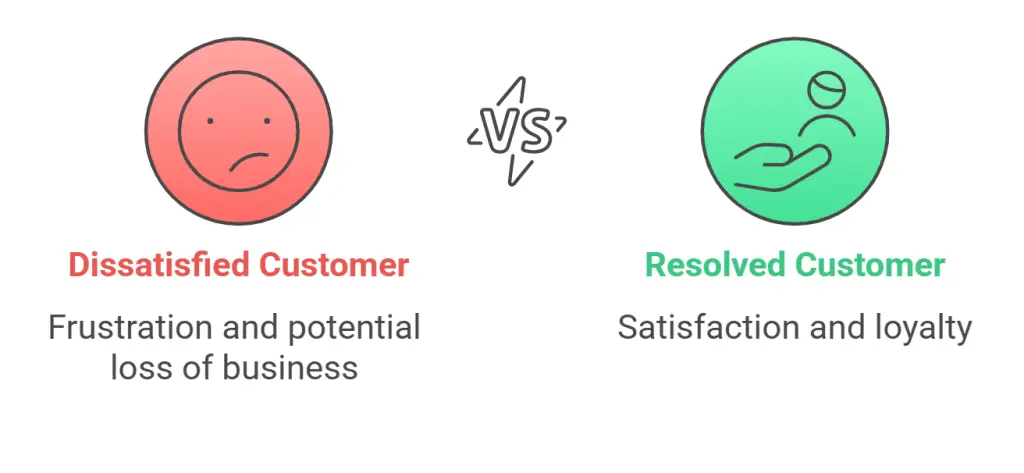
Understanding Difficult Customers
Common Types of Difficult Customers
Difficult customers can come in many forms, and recognizing their behavior patterns is the first step toward effectively managing interactions with them. Below are some of the most common types of difficult customers:
- The Angry Customer – This type of customer is visibly upset, often raising their voice or making aggressive statements. They may feel wronged due to poor service, a defective product, or an unresolved issue. Their anger might not even be entirely about your business; it could stem from personal frustrations that they project onto the situation.
- The Impatient Customer – This customer demands immediate attention and expects quick fixes. They may become irritable if they feel they are waiting too long or if solutions are not provided instantly.
- The Know-It-All Customer – Some customers believe they are experts and challenge your knowledge. They might dismiss your recommendations or insist on their own solutions, sometimes undermining your authority in the process.
- The Indecisive Customer – Struggling to make a choice, these customers often go back and forth between options, requiring extra time and reassurance before making a decision.
- The Complaining Customer – These customers are rarely satisfied, even when provided with reasonable solutions. However, they continue to engage with your business because they still see value in what you offer.
- The Silent Customer – Some customers do not voice their concerns or complaints directly. Instead, they might take their frustrations online, leaving negative reviews or simply discontinuing their patronage without warning.
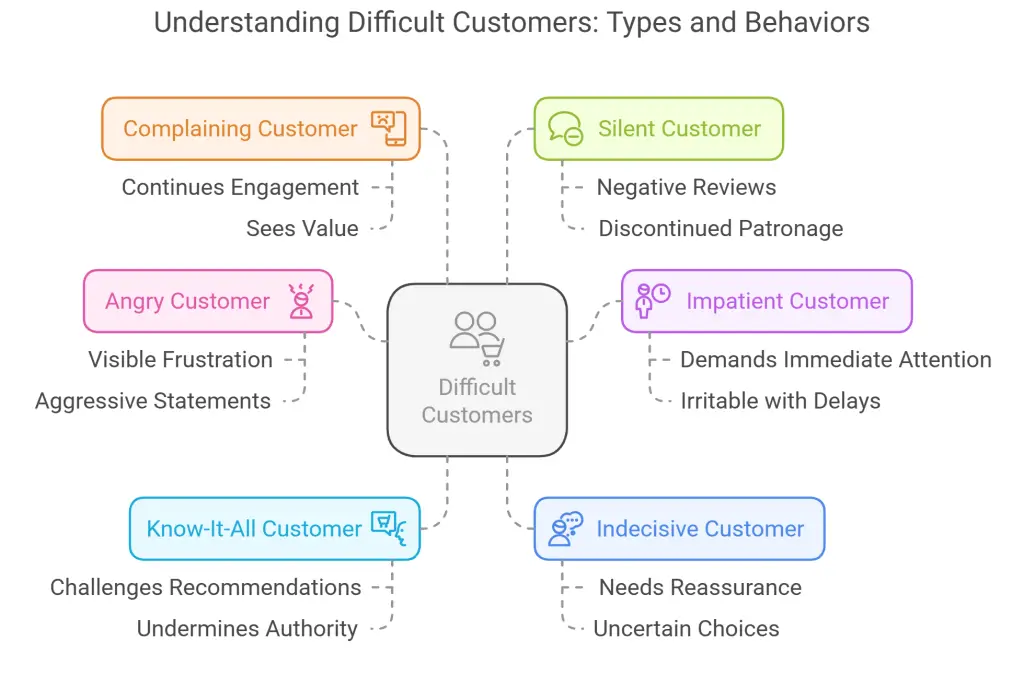
Why Customers Get Difficult
Understanding the root causes of difficult behavior can help you approach interactions with greater patience and effectiveness. Customers may become difficult due to:
- Unmet expectations – If the customer expected a different experience, they might feel disappointed or even deceived.
- Poor past experiences – A previous negative experience with customer service (whether with your business or another) can make customers more defensive.
- Miscommunication – A lack of clarity regarding product descriptions, service policies, or pricing can lead to misunderstandings and frustration.
- Personal stress or external factors – Sometimes, customers project unrelated frustrations onto their current situation, making them more sensitive to minor issues.
- Desire for acknowledgment – Some customers feel unheard and become difficult to ensure their concerns are addressed.
- Cultural or language barriers – Misunderstandings due to language differences or varying cultural expectations can lead to dissatisfaction.
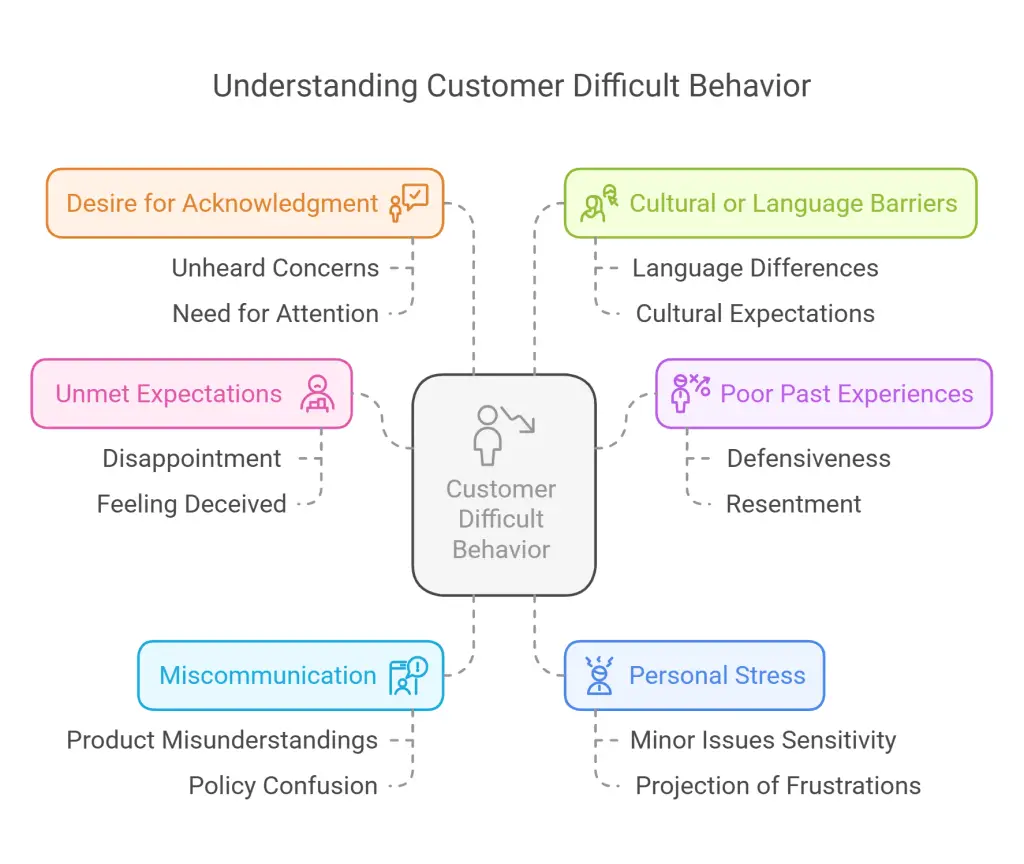
By recognizing these factors, you can adjust your approach to better address concerns, de-escalate tension, and provide meaningful resolutions.
2. Strategies for Handling Difficult Customers Offline (In-Person Interactions)
Maintaining Composure and Professionalism
Dealing with difficult customers face-to-face requires emotional control and professionalism. It’s easy to get flustered or react defensively, but maintaining composure is crucial. Here’s how:
- Stay calm – Take a deep breath and remind yourself that the customer’s frustration is not personal.
- Use neutral body language – Maintain an open posture, make eye contact, and avoid defensive gestures like crossing your arms.
- Keep your tone controlled – Speak in a steady, professional tone to avoid escalating the situation.
- Let them vent (within reason) – Sometimes, customers just need to feel heard before they can accept a resolution.
- Demonstrate confidence without arrogance – Being firm yet respectful helps establish authority while maintaining good customer relations.

Active Listening and Empathy
Listening is a powerful tool for de-escalation. Customers want to feel valued, and showing empathy can change the tone of an interaction:
- Let them speak without interruption – Avoid the urge to correct them mid-sentence.
- Acknowledge their frustration – Use empathetic phrases like “I understand why this is frustrating.”
- Use reflective listening – Summarize their concern to ensure understanding: “So, you’re upset because your order was delayed. Let’s see what we can do to fix that.”
- Maintain eye contact and nod occasionally – This reassures the customer that you are genuinely engaged in the conversation.
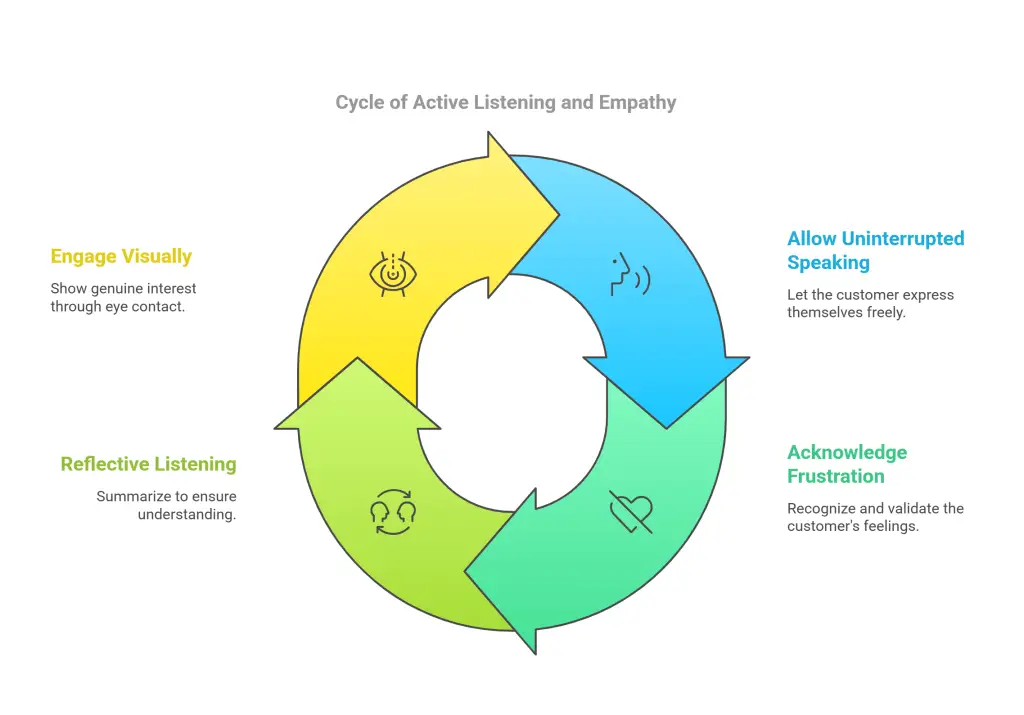
Apologizing and Finding Solutions
A well-placed apology can go a long way, but it’s important to phrase it properly:
- Say sorry without admitting fault unnecessarily – “I’m sorry for the inconvenience” works better than “We messed up.”
- Offer clear solutions – Instead of justifying the problem, focus on fixing it.
- Give the customer choices – When possible, offer multiple options for resolution to make them feel empowered.
- Follow through on commitments – Ensure the promised solution is delivered promptly to avoid further dissatisfaction.
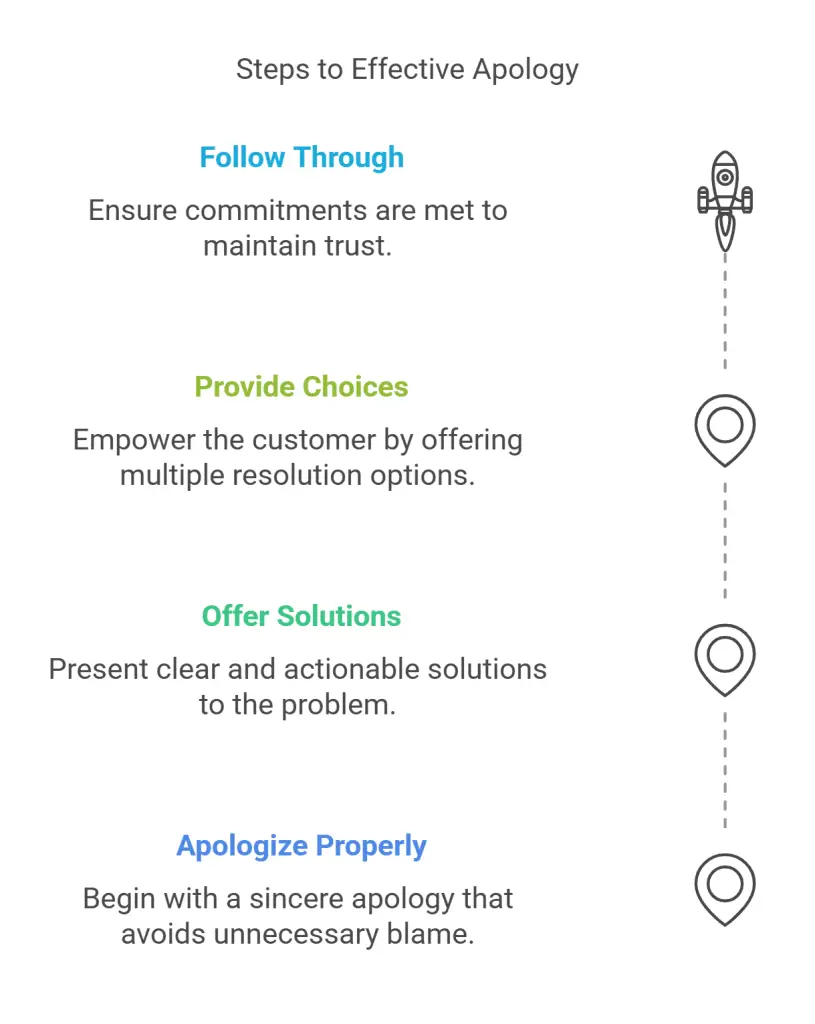
Setting Boundaries and Dealing with Abusive Behavior
Some customers cross the line into verbal abuse or unreasonable demands. It’s essential to set boundaries:
- Politely but firmly redirect – “I understand your frustration, but I need us to communicate respectfully.”
- Know when to disengage – If a customer becomes abusive, don’t be afraid to remove yourself or call security if necessary.
- Ensure your team has clear policies – Have a plan in place for handling aggressive customers safely.
- Remain professional even if the customer does not – Upholding high standards of conduct reflects well on your business.
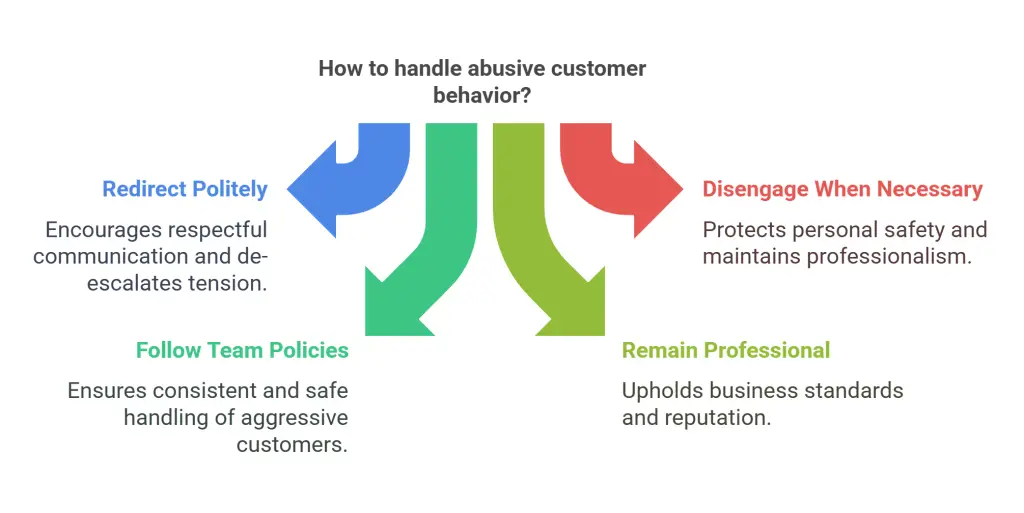
Follow-Up After Resolving the Issue
- Send a thank-you note or discount for future purchases – This can help turn a difficult situation into a long-term positive relationship.
- Confirm that the issue is resolved – A quick follow-up call or email ensures customer satisfaction and prevents recurring problems.
- Document interactions – Keeping records of customer interactions can help track patterns and improve service protocols.
Offline Case Study: Handling an Angry Customer in a Retail Store
Scenario:
Emma owns a boutique clothing store. One afternoon, a customer, Mr. Thompson, storms in, visibly upset. He purchased a jacket a week ago, and the zipper broke. He demands an immediate refund, raising his voice and accusing the store of selling defective products.

How Emma Handled the Situation:
- Stayed Calm and Listened: Instead of reacting defensively, Emma maintained a neutral and professional demeanor. She let Mr. Thompson express his frustration without interruption.
- Showed Empathy: After he finished, she acknowledged his frustration: “I completely understand how frustrating this must be. You expected a high-quality product, and it didn’t meet your expectations.”
- Examined the Issue and Offered Solutions:
- She inspected the jacket and confirmed the zipper was faulty.
- She explained the store’s policy: exchanges were available, but refunds were only for unworn items.
- She offered Mr. Thompson two solutions:
- A free repair with priority service.
- A replacement with a 10% discount on his next purchase.
- Defused the Situation: Mr. Thompson initially resisted but calmed down after realizing he had options. He chose the replacement jacket.
- Followed Up: A week later, Emma sent him a personalized email checking if he was satisfied. He appreciated the effort and later left a positive review about the store’s customer service.
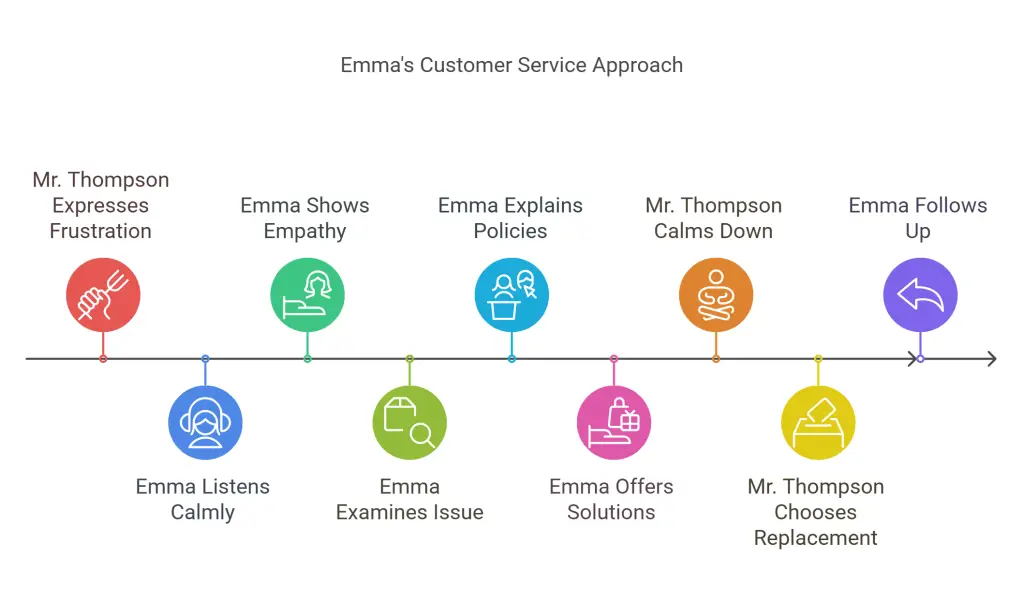
Takeaway:
Staying calm, listening, and offering solutions prevented escalation and turned an angry customer into a satisfied one.
Strategies for Handling Difficult Customers Online (Emails, Chat, Social Media, Reviews)
A. Responding to Negative Comments and Reviews
- Acknowledge publicly, resolve privately: Avoid ignoring negative reviews—respond professionally and invite further discussion via direct message.
- Avoid defensiveness: Instead of making excuses, focus on understanding the customer’s concern and offering a resolution.
- Encourage revised feedback: If a resolution is reached, kindly ask if they would consider updating their review.
B. Managing Difficult Customers on Social Media
- Respond quickly: Timely responses show attentiveness and professionalism.
- Move complaints to private channels: Ask customers to message you directly to prevent public disputes.
- Monitor brand mentions: Proactively address potential issues before they escalate.
C. Email and Live Chat Etiquette
- Use professional, courteous language: Keep responses clear, concise, and free of frustration.
- Provide resources: Direct customers to FAQs, guides, or support articles to preemptively solve common issues.
- Set expectations: Give a clear timeline for response and resolution.
D. Preventing Future Issues with Proactive Customer Support
- Create a knowledge base: Offer self-help resources to minimize recurring problems.
- Automate FAQs and responses: Chatbots can provide quick solutions to common inquiries.
- Train support teams in digital interactions: Ensure customer service teams maintain professionalism in online responses.
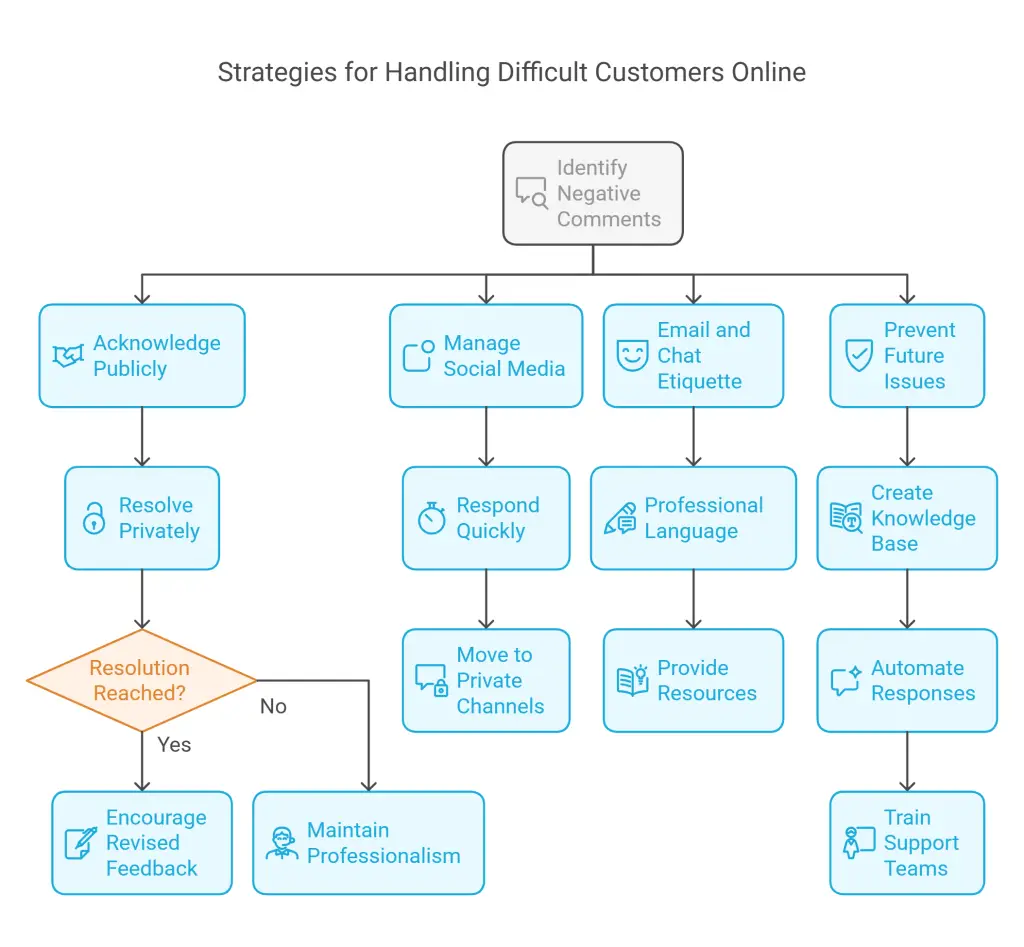
Online Case Study: Managing a Negative Review on Social Media
Scenario:
Lisa runs an online handmade jewelry store. One day, she notices a scathing 1-star review on her Facebook business page from a customer named Sarah. The review states that Lisa’s bracelets are “overpriced, poorly made, and not worth the money.” Sarah also claims she received slow customer service when she inquired about shipping delays.

How Lisa Handled the Situation:
- Responded Promptly and Publicly: Lisa didn’t ignore the comment or delete it. Instead, she responded professionally within two hours:
- “Hi Sarah, I’m sorry to hear that you weren’t satisfied with your order. I truly value my customers, and I’d love to make this right.”
- Acknowledged the Issue Without Being Defensive:
- “Our handmade bracelets are crafted with high-quality materials, but I understand that expectations can vary. I’d love to learn more about what specifically disappointed you so I can improve.”
- Offered a Solution:
- A full refund if Sarah wanted to return the bracelet.
- A replacement bracelet of equal value at no extra charge.
- Took the Conversation Offline: To prevent a back-and-forth debate in the comments, Lisa invited Sarah to message her directly:
- “Please send me a direct message, and I’ll personally ensure we find a resolution that works for you.”
- Final Outcome: Sarah messaged privately, explaining her concerns. Lisa issued a refund, and Sarah updated her review from 1 star to 4 stars, adding:
- “At first, I was frustrated, but Lisa handled my issue with kindness. I appreciate the excellent customer service.”
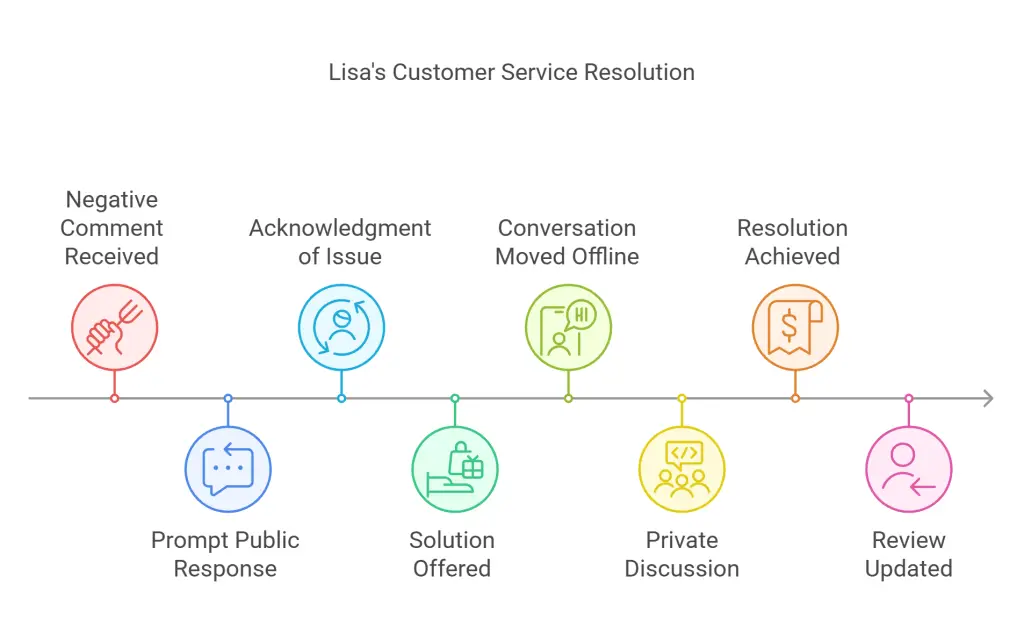
Takeaway:
A negative review doesn’t have to damage a business. A professional, empathetic response, combined with a genuine effort to resolve the issue, can turn unhappy customers into loyal ones.
Turning Negative Experiences into Positive Outcomes
Negative customer interactions don’t have to result in lost business. By leveraging complaints as learning opportunities, businesses can refine their services, boost customer retention, and even transform frustrated customers into loyal brand advocates. Every complaint is an insight into areas that might need improvement, whether it’s product quality, communication, or service speed. Understanding the psychology behind customer dissatisfaction allows businesses to develop proactive strategies that prevent recurring issues and enhance the overall customer experience.
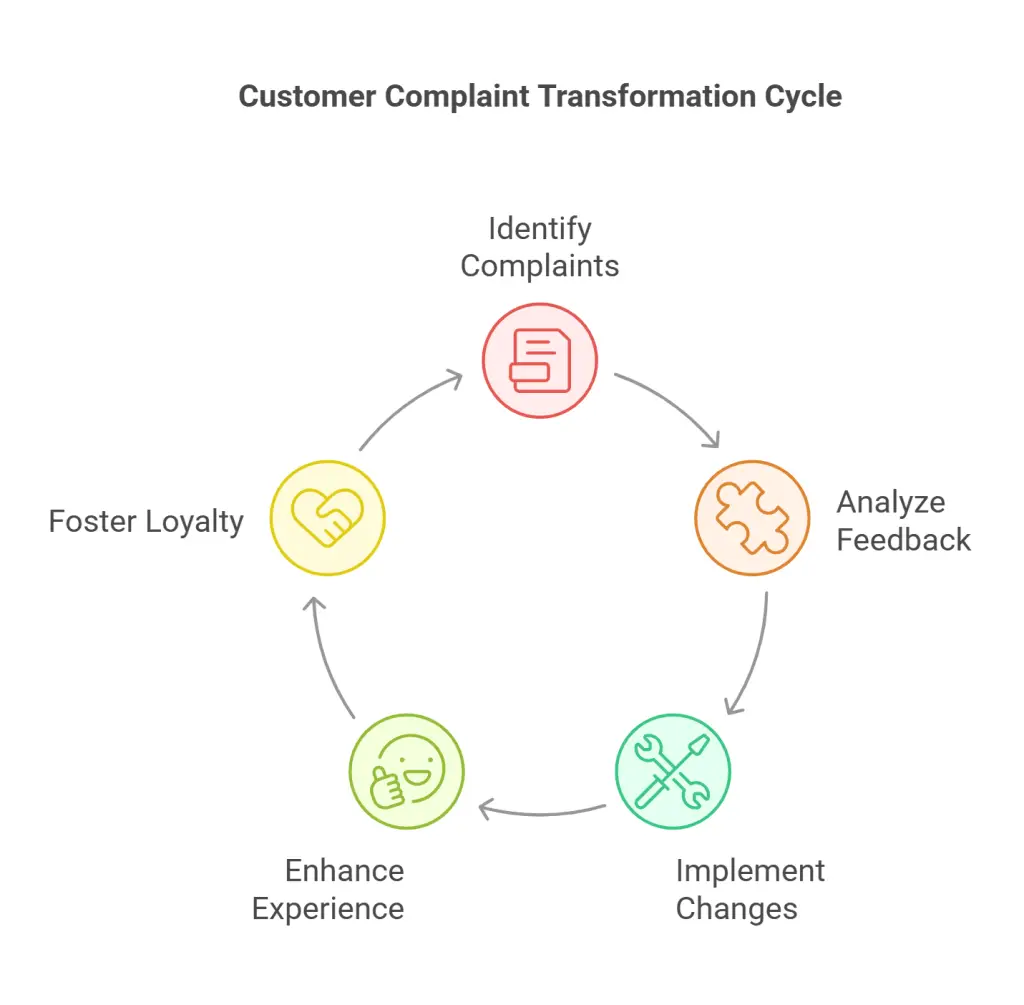
Learning from Complaints to Improve Services
- Track patterns in customer feedback: Identify recurring complaints and implement changes before they escalate into widespread dissatisfaction.
- Analyze reviews and feedback: Look at customer feedback across multiple platforms—social media, review sites, email inquiries—to detect consistent themes.
- Monitor competitor strategies: Learn from businesses with strong reputations for handling customer complaints effectively.
- Seek direct input from customers: Conduct surveys or follow-up calls to ask how you can improve their experience.
- Refine internal processes: Ensure your policies, response times, and service standards align with customer expectations.
- Leverage technology: Use CRM systems to track and categorize complaints, making it easier to identify trends and implement data-driven improvements.
- Track patterns in customer feedback: Identify recurring complaints and implement changes.
- Analyze reviews and feedback: Use insights to enhance products or services.
- Monitor competitor strategies: Learn from businesses with strong reputations for handling customer complaints effectively.
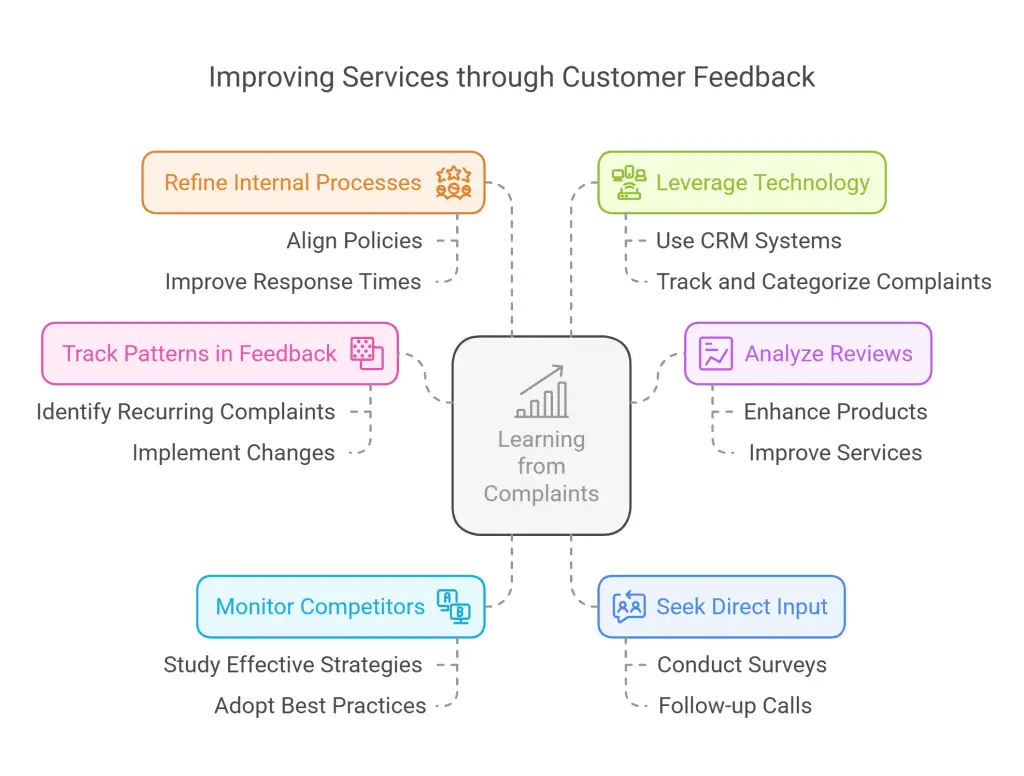
Encouraging Unhappy Customers to Give Your Business Another Chance
- Offer incentives with boundaries: While discounts or freebies can help regain trust, they should be used strategically to prevent setting unrealistic expectations.
- Request feedback on improvements: Engage dissatisfied customers in shaping better service experiences by asking what changes they’d like to see.
- Personalize outreach: A follow-up email or phone call expressing genuine concern can go a long way in rebuilding trust.
- Showcase changes publicly: If your business implements changes based on customer feedback, let your audience know through blog posts, social media updates, or newsletters.
- Highlight success stories: Sharing testimonials from customers who had initially bad experiences but were won over through excellent service can help build credibility and trust.
- Offer incentives with boundaries: Discounts or freebies can help regain trust but should be used strategically.
- Request feedback on improvements: Engaging customers in solutions makes them feel valued.
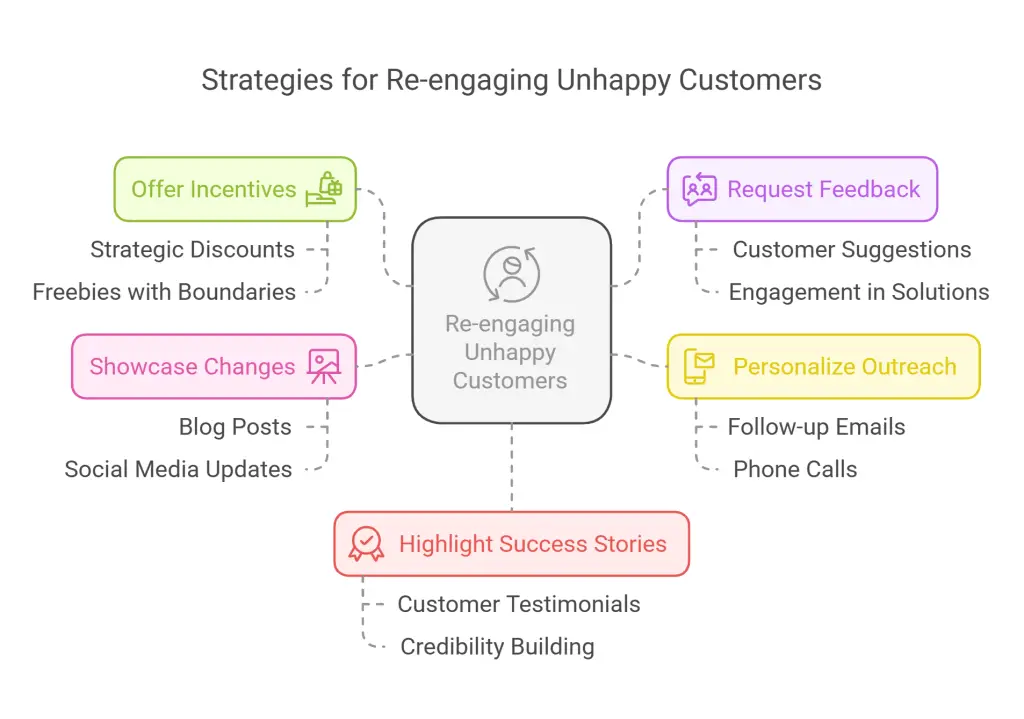
Training Your Team for Difficult Customer Scenarios
- Develop customer service scripts: Prepared responses help ensure consistency and professionalism across all interactions.
- Conduct role-playing exercises: Simulating difficult interactions ensures staff readiness and enhances confidence in handling tough situations.
- Encourage a customer-first mindset: Reinforce empathy, patience, and problem-solving skills as core values within the team.
- Teach de-escalation techniques: Employees should be trained to diffuse tense situations calmly and professionally.
- Empower employees with solutions: Ensure your team has the authority to resolve minor complaints without needing managerial approval, reducing frustration for both customers and staff.
- Continuously update training modules: Keep learning materials relevant by incorporating real-life scenarios, industry trends, and evolving customer expectations.
- Develop customer service scripts: Prepared responses can help maintain consistency.
- Conduct role-playing exercises: Simulating difficult interactions ensures staff readiness.
- Encourage a customer-first mindset: Empathy and patience should be core values.
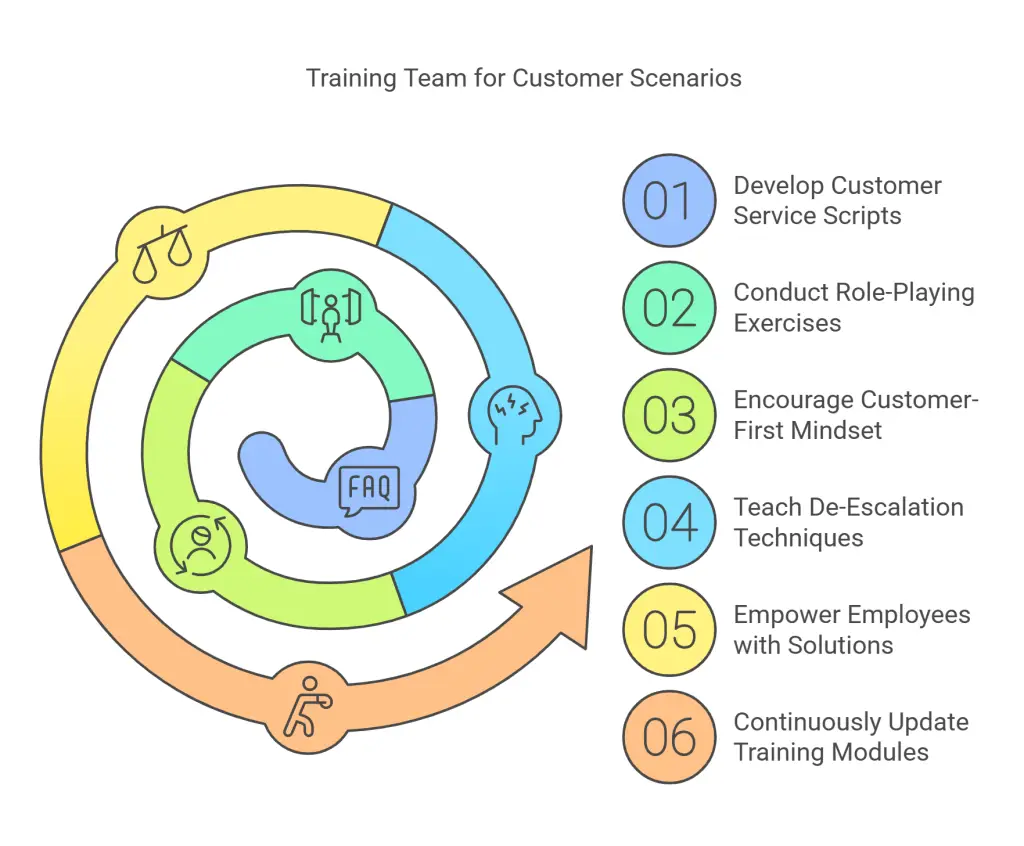
Conclusion
Handling difficult customers—both online and offline—requires patience, empathy, and professionalism. By staying calm, listening actively, and offering practical solutions, businesses can turn negative situations into opportunities for customer satisfaction and loyalty.
Difficult customers are inevitable, but with the right approach, they can become some of your most loyal supporters. Always prioritize excellent customer service while maintaining healthy business boundaries.
Frequently Asked Questions
What are common types of difficult customers?
Common types include angry customers, impatient customers, know-it-all customers, indecisive customers, complaining customers, and silent customers.
Why do customers become difficult?
Customers may become difficult due to unmet expectations, poor past experiences, miscommunication, personal stress, desire for acknowledgment, or cultural and language barriers.
How can businesses effectively handle angry customers?
Businesses can handle angry customers by staying calm, actively listening, empathizing with their concerns, apologizing sincerely, and offering practical solutions to resolve the issue.
What strategies help in managing impatient customers?
To manage impatient customers, acknowledge their urgency, provide clear timelines, keep them informed, and expedite service when possible to meet their expectations.
How should businesses deal with know-it-all customers?
When dealing with know-it-all customers, show respect for their knowledge, provide additional information diplomatically, and guide the conversation to mutually beneficial solutions.
Further reading
Google Support. “Angry Customer Posting False Reviews – Help!” Google Business Profile Help Forum. Accessed February 20, 2025. https://support.google.com/business/thread/95736221/angry-customer-posting-false-reviews-help?hl=en.
How to Sell Your Stuff. “Angry Customers & Bad Reviews on Etsy.” How to Sell Your Stuff Blog, March 10, 2023. Accessed February 20, 2025. https://www.howtosellyourstuff.com/blog/angry-customers-bad-reviews-on-etsy.
The Review Trackers Team. “How to Deal with Negative Reviews: Advice, Removal, and Response – The Ultimate Guide.” Reviews.io Blog, March 1, 2023. Accessed February 20, 2025. https://blog.reviews.io/post/how-to-deal-with-negative-reviews-advice-removal-and-response-the-ultimate-guide.
Square Community. “How Do You Handle Bad Reviews and/or Disgruntled Customers?” Square Community Corner Forum, September 12, 2023. Accessed February 20, 2025. https://community.squareup.com/t5/Community-Corner/How-do-you-handle-bad-reviews-and-or-disgruntled-customers/td-p/377230.
ReviewTrackers. “Examples of How to Respond to Negative Reviews.” ReviewTrackers Guides, January 15, 2024. Accessed February 20, 2025. https://www.reviewtrackers.com/guides/examples-responding-reviews/.
Thrive by Design. “How to Deal with Negative Customer Feedback.” YouTube Video, uploaded February 5, 2024. Accessed February 20, 2025. https://www.youtube.com/watch?v=H1KGDzfsqy0.
Modern Millie. “Handling Bad Reviews as a Small Business Owner.” YouTube Video, uploaded March 20, 2024. Accessed February 20, 2025. https://www.youtube.com/watch?v=mbQiJLl86NA.







